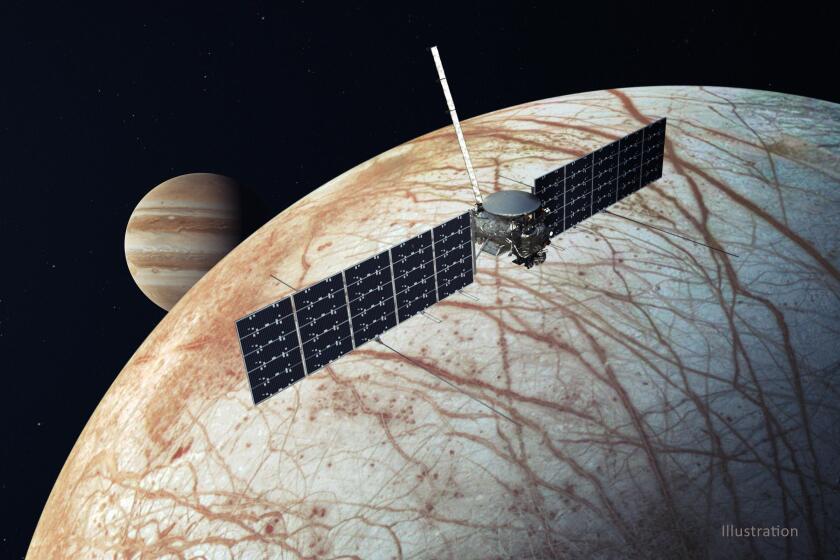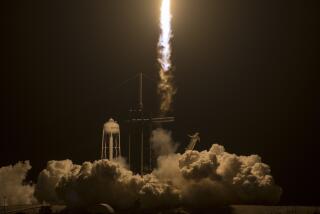NASA launches Europa Clipper to see if Jupiter’s icy moon has ingredients for life

A SpaceX Falcon Heavy rocket lifted off from Cape Canaveral, Fla., on Monday morning carrying a NASA probe designed to explore Jupiter’s icy moon Europa and search for the building blocks of life.
With the Europa Clipper now on its 1.8-billion mile, 5½-year journey to the solar system’s largest planet, NASA has officially retired a “tremendous amount of risk on the mission,” according to Jordan Evans, Europa Clipper project manager at NASA’s Jet Propulsion Lab.
The flight’s initial stages went according to their carefully choreographed plan.
The spacecraft lifted off at 9:06 a.m. Pacific time, and the side boosters that helped fuel its fiery ascent broke away from the rocket a little more than three minutes into the flight. The main booster shut down and fell back to Earth about a minute later.
The fairing that secured Clipper at the top of the rocket separated about 4½ minutes into the flight.
After an initial eight-minute burn, the spacecraft entered a “coasting orbit” around Earth. A second, shorter engine burn positioned Clipper on a trajectory to exit Earth’s embrace.
NASA JPL’s Europa Clipper spacecraft, the largest planetary probe ever built, will launch as early as Friday to explore Jupiter’s icy ocean moon.
Teams at the Jet Propulsion Laboratory in La Cañada Flintridge applauded when the spacecraft separated from the rocket a little more than an hour after the launch. With its twin solar panels still folded up tight, the probe resembled a cube.

“Please say goodbye to Clipper on its way to Europa,” said Pranay Mishra, the mission’s flight director at JPL.
A second round of cheers erupted about five minutes later, when direct communication with the spacecraft was confirmed.
Mission managers noted signs that the propulsion system failed to vent, but the craft rolled into its desired position. That was seen as evidence that the propulsion system is working fine.
Clipper’s journey to Europa will not be direct. It will get a gravity assist by sling-shotting around Mars early next year, then boomerang back around Earth in late 2026 before zooming toward Jupiter and the gas giant‘s icy, dynamic moon.
The probe is scheduled to arrive in 2030 and gather data for more than four years.
When the mission ends, Clipper will fly itself into one of Jupiter’s rocky moons to ensure the spacecraft doesn’t contaminate Europa.
Searching for the ingredients for life on Europa will be a challenge for NASA’s Europa Clipper spacecraft. Surviving the high radiation of the icy moon will be even harder.
The launch was initially scheduled for Thursday, but Clipper spent that day secured in SpaceX’s hangar to ride out Hurricane Milton. The skies over Florida’s space coast were clear with few wispy clouds Monday morning.
Scientists have advocated for a Europa mission for decades, ever since NASA’s Galileo probe found that the moon likely has a subterranean global ocean, heated by Jupiter’s gravitational forces compressing and stretching the moon’s core as it orbits the gas giant at break-neck speed.
With water, an energy source in the form of heat, and potentially organic compounds, scientists say Europa could be hospitable for alien life.
While orbiting Jupiter, Clipper will fly by Europa dozens of times and use its array of scientific instruments to study the dynamics of the moon’s subterranean ocean and look for organic compounds, a potential indicator of life.
Are you a space nerd? Consider taking a hike at Mt. Wilson, where discoveries of how our universe works continue to be made.
The $5-billion Europa Clipper mission was designed and built by JPL . It’s the largest planetary probe ever built by NASA .
To launch the spacecraft, SpaceX employed its Falcon Heavy rocket, a variant of its Falcon 9 with an extra booster strapped to each side.
While SpaceX usually attempts to recover its boosters, this time, it let them fall into the ocean — expending all of their propellant on getting Clipper out of Earth’s gravity instead of saving some fuel to land. The fairings that protect the spacecraft as it leaves Earth will be recovered.
“The community is really fortunate to have new rockets with these heavy lift capabilities available to them,” said Matthew Shindell, planetary science and exploration curator at the Smithsonian National Air and Space Museum. “If you were trying to launch a mission like this a decade ago, you couldn’t do it.”










